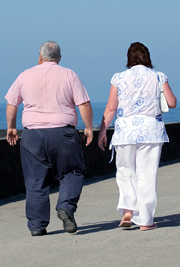 Maintaining Aerobic Fitness Could Delay Biological Ageing By Up To 12 Years
Maintaining Aerobic Fitness Could Delay Biological Ageing By Up To 12 YearsRegular exercise reduces the risk for obesity, maturity onset diabetes, hypertension, cardiovascular disease, several forms of cancer and osteoporosis not only in middle age but also in the retirement years.
The maintenance of aerobic fitness through middle age and beyond can also delay biological ageing by up to 12 years and prolong independence during old age, according to Roy Shephard, Professor Emeritus of Applied Physiology, University of Toronto, in the British Journal of Sports Medicine (1).
Aerobic exercise, such as jogging, improves oxygen consumption in the body as well as its use in generating energy.
But maximal aerobic power starts to fall predictably beginning in middle age, decreasing about 5mL/kg/min every decade of life.
In a typical sedentary man, by the age of 60 years, the maximal aerobic power will have fallen to about 25 mL/kg/min -- this is almost half what it was at age 20. If such losses continue into old age, a point is reached when the ordinary activities of ordinary independent daily life become intolerably fatiguing.
Dr. Shephard combines data from many different sources to conclude that regular aerobic exercise can inhibit or even reverse this continuous decline, even later in life.
A regular exercise programme can slow or reverse the loss of aerobic fitness, prolonging the elderly individual's independence and reducing risks of serious disease, faster recovery after injury or illness, and risks of falls because of the maintenance of muscle power, balance, and coordination.
So You May Ask: Is Tai Chi Beneficial For Improving Aerobic Capacity?
Dr M Soo Lee (2) from the Korea Institute of Oriental Medicine working with colleagues from the Universities of Exeter & Plymouth, UK and Dong-A University, South Korea evaluated evidence from 5 randomised clinical trials (RCTs) testing the effectiveness of tai chi for increasing aerobic capacity. Three RCTs compared the effects of tai chi with no treatment. The meta-analysis failed to show an effect of tai chi on aerobic capacity compared with sedentary control. Two RCTs compared tai chi with conventional physical exercise including brisk, low intensity and moderate intensity walking, and aerobic exercise.
Their results show that tai chi was not statistically significantly superior to physical exercise suggesting that regular tai chi is not an effective way of increasing aerobic capacity.
So What’s So Good About Tai Chi?
Despite its long history, tai chi has been studied scientifically only in recent years. And although more research is needed, preliminary evidence suggests that tai chi may offer numerous benefits beyond stress reduction, including:
- Reducing anxiety and depression
- Improving balance, flexibility and muscle strength
- Reducing falls in older adults
- Improving sleep quality
- Lowering blood pressure
- Improving cardiovascular fitness in older adult
- Relieving chronic pain
- Increasing energy, endurance and agility
- Improving overall feelings of well-being
Source: Mayo Clinic
We Recommend Tai Chi and Brisk Walking
Brisk walk training in previously sedentary men and women can result in a substantial increase in aerobic capacity and a reduction in body weight and fat stores, particularly when the walking duration exceeds 30 minutes (3).
The Zestzfulness Team recommends combining tai chi with brisk walking because of the lesser physical stress on muscle and bone of the leg, knees and feet than jogging or running.
Journal Reference- R J Shephard. Maximal oxygen intake and independence in old age. British Journal of Sports Medicine. 2009;43:342-346
- Lee MS, Lee E-N, Ernst E. Is tai chi beneficial for improving aerobic capacity? A systematic review. British Journal of Sports Medicine. 2009;43:569-573
- Franklin BA. Walking: the undervalued prescription. Preventive Cardiology. 2006 Winter;9(1):56-9.
Aerobic power is dependent on the ability of the respiratory and circulatory systems to transport oxygen from the air to the respiring tissues, and the ability of the tissues to use the oxygen to break down metabolic fuels. Aerobic power is usually measured in terms of oxygen consumption per unit of time.Aerobic power, aerobic capacity, functional capacity, functional aerobic capacity, maximal functional capacity, cardiorespiratory fitness, cardiovascular fitness, maximal oxygen intake, and maximal oxygen uptake are terms that are often used interchangeably.
Picture Source






















